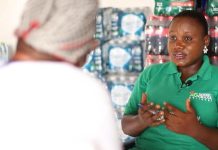Recent developments: Output in the Sub-Saharan Africa region contracted by an estimated 3.7% in 2020, as the COVID-19 pandemic and associated lockdowns disrupted economic activity. As a result, per capita income shrank by 6.1% in 2020, setting average living standards back by at least a decade in a quarter of Sub-Saharan African economies.
The hardest hit were countries with large domestic outbreaks, those heavily dependent on travel and tourism, and commodity exporters, particularly oil exporters. COVID-19 outbreaks persisted in the second half of last year in several countries, with little sign of abating.
In Nigeria and South Africa, output fell sharply last year. Nigeria’s economy is estimated to have contracted 4.1% in 2020, as the effects of the pandemic impacted economic activity in all sectors.
In South Africa, where economic activity was on weak footing before COVID-19, output is estimated to have fallen 7.8% last year. The country suffered the most severe outbreak of the pandemic in the region and underwent strict lockdowns that brought the economy to a standstill.
Oil exporters in the region grappled with sharply lower prices (Angola, Equatorial Guinea, Republic of Congo, South Sudan), while those with large travel and tourism sectors endured near-complete shutdowns of visitor activity (Cabo Verde, Ethiopia, Mauritius, Seychelles).
Contractions in agricultural commodity exporters were less steep (Benin, Côte d’Ivoire, Malawi, Uganda).
Outlook: Growth in the region is forecast to rebound moderately to 2.7% in 2021. While the recovery in private consumption and investment is forecast to be slower than previously envisioned, export growth is expected to accelerate gradually, in line with the rebound in activity among major trading partners.
The resumption in activity in major advanced and emerging economies and key trading partners of the region (Europe, China, US) is chiefly underpinned by positive news on vaccine development and rollout as well as new rounds of fiscal stimulus.
Expectations of a sluggish recovery in Sub-Saharan Africa reflect persistent COVID-19 outbreaks in several economies that have inhibited the resumption of economic activity. The pandemic is projected to cause per capita incomes to decline by 0.2% this year, setting Sustainable Development Goals (SDGs) further out of reach in many countries in the region.
This reversal is expected to push tens of millions more people into extreme poverty over last year and this year. Growth in Nigeria is expected to resume at 1.1% in 2021. Activity is nevertheless anticipated to be dampened by low oil prices, OPEC quotas, falling public investment due to weak government revenues, constrained private investment due to firm failures, and subdued foreign investor confidence. In South Africa, growth is expected to rebound to 3.3% in 2021.
An expectation of weak growth momentum reflects the lingering effects of the pandemic and the likelihood that some mitigation measures will need to remain in place. The rebound is expected to be slightly stronger—although below historical averages—among agricultural commodity exporters.
Higher international prices for agricultural commodities are expected to buoy activity. The recovery is forecast to be more anemic among industrial commodity exporters. Although metal prices recovered somewhat in the second half of last year, oil prices remain well below 2019 levels, weighing on oil exporters (Angola, Chad, Equatorial Guinea, Gabon, Ghana, Republic of Congo).
Risks: Risks are tilted to the downside. Growth in major trading partners could fall short of expectations. Widescale distribution of a COVID-19 vaccine in the region will likely face many hurdles, including poor transport infrastructure and weak health systems capacity. Such constraints, compounded by natural disasters such as recent devastating floods and rising insecurity, particularly in the Sahel, could delay recovery.
Government debt in the region has increased sharply to an estimated 70% of GDP last year, elevating concerns about debt sustainability in some economies. Banks may face sharp increases in non-performing loans as companies struggle to service their debt due to falling revenues.
Lasting damage of the pandemic could depress growth over the long term through the chilling effects of high debt on investment, the impact of lockdowns on schooling and human capital development, and weaker health outcomes.
Credit: Maxwell Awumah












































